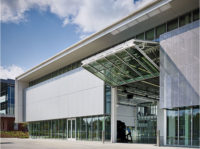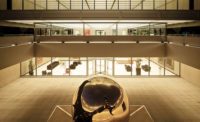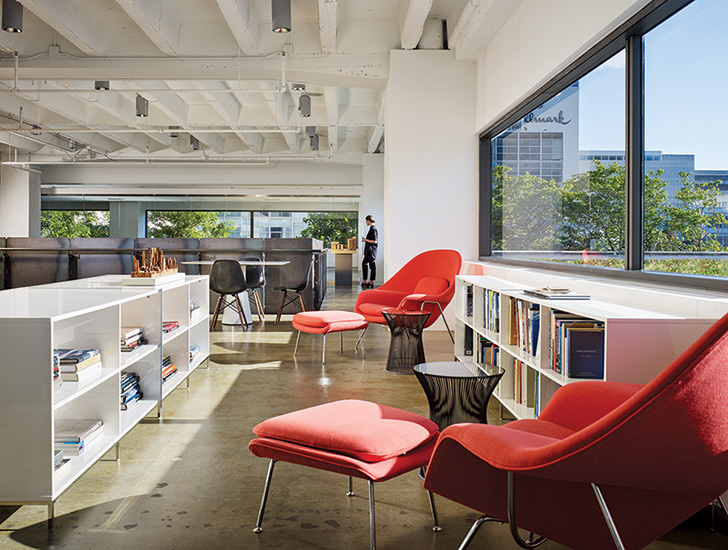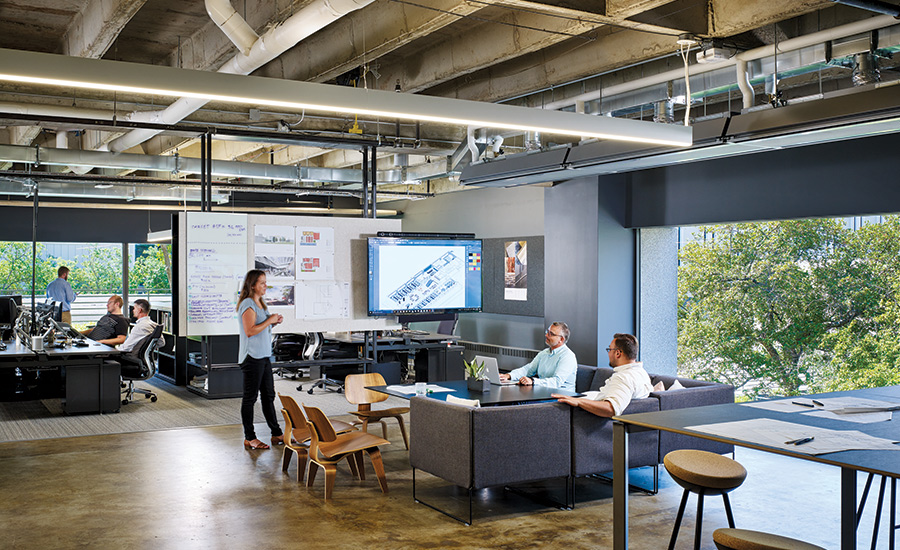BNIM Offices at Crown Center by BNIM
Kansas City, Missouri

The architects made the most of the minimal tenant-improvement allowance by keeping the interior raw. The only big move was the removal of a 24-foot-square section of the concrete slab to join the floors. The balustrades are sheet steel discolored by laser cutting.
Photo © Michael Robinson

The office entrance is on the upper floor, where a small reception area and coffee shop welcome visitors and employees.
Photo © Nick Merrick

BNIM’s offices are indicated by the ochre-tinted section of the photo of the 1970s late modern complex.
Photo courtesy BNIM

The space was originally filled with workstations that blocked views to the grounds outside.
Photo courtesy BNIM

Now “the Boulevard” bisects the ground floor, where everybody can see out.
Photo © Michael Robinson

Contemporary furnishings create comfortable meeting areas on the upper and lower levels.
Photo © Nick Merrick

26-foot-wide by 6-foot-8-inch-high windows on the lower floor have the visual effect of bringing trees and the garden into the interior.
Photo © Nick Merrick

“The Boulevard” features long farmhouse tables made from solid-wood-core doors BNIM salvaged from the demolition phase of a project.
Photo © Nick Merrick

Image courtesy BNIM

Image courtesy BNIM

Image courtesy BNIM











Architects & Firms
Ever since BNIM’s predecessor firm, PBNA, was founded in 1970, its principals have committed themselves to helping revive Kansas City’s deteriorating downtown by keeping their offices there. For years they were the only tenant in the Kansas City Power and Light building, a once-glorious 1931 Art Deco office tower. “There was nothing there but feral cats, pigeons, and us,” says BNIM principal Steve McDowell.
Additional Content:
Jump to credits & specifications
But while being in an old building was cool, it didn’t allow the flexibility and ease of communication that a modern architectural practice demands. At the Power and Light building, the principals were grouped on a mezzanine that was separated from the studios, which were stacked on floors above and below them. Communication was poor. Reconfiguring the office layout would be painful. And while BNIM was known for designing connections to nature for its clients’ buildings, its own office was surrounded by streets and grim parking lots.
When the building’s owner decided to turn it into condominiums, the firm moved to another downtown building. And after the potential renovation of that space fell through in June of 2016, the architects decided to look for one beyond the downtown for the first time. With a lease expiring and seven months to find a new location, design, build, and move into it, they settled on two floors in a 1971 five-building concrete office complex designed by Edward Larrabee Barnes that is part of Crown Center.
Barnes’s buildings were the first constructed at this highly successful mixed-use development built by the Hall family next to their Hallmark Cards headquarters. The concrete structures are clad in tan precast panels that frame enormous panes of tinted glass. After more than 45 years, their facades remain unsullied by corporate-tenant signage or other alterations.
A 1970s concrete building might seem like the last place an architecture firm whose principals helped found the U.S. Green Building Council would move. But, inside, Barnes’s panoramic 26-foot-wide windows, which fit within the structure’s generous 30-foot column spacing, offer spectacular views to the mature trees and gardens outside, and of Crown Center’s 10-acre public plaza and fountains.
“Having a strong eye-level connection to nature made the difference in this tenant space,” says design team member Rohn Grotenhuis. “We preserved and enhanced this condition with the openness of our layout, dark color tones, and lower lighting levels. It’s a little like a secret garden. A visitor doesn’t expect that indoor-outdoor connection in this Brutalist building.”
The construction budget set by the owner’s tenant-improvement allowance was minimal, as was the compressed schedule, so the architects went minimalist too, polishing the concrete floors and exposing the concrete pan-joist structure, ducts, electrical, and cable trays. The sole big move was cutting a 24-foot-square hole through the slab separating the two floors and connecting them with a stair. A long, open space called “the Boulevard” extends from the bottom of this stairway toward one of the sweeping views of the trees and plaza. Here employees meet at custom-made farmhouse tables to eat, work, and gather for informal conversations.
There are no private offices. Conference rooms large and small afford privacy if needed. Desk assignments in the open studio areas are flexible, so that a principal might be sitting at a workstation alongside a young employee, an arrangement that minimizes overt hierarchical office structure and facilitates the sharing of knowledge. Wi-Fi and monitors that anyone can use to stream content mean pop-up studios are created on the fly just by people with their laptops getting together. Business phone numbers are ported to each employee’s cell phone, so desktop landlines have been eliminated.
The new environment has yielded almost immediate gains in productivity and revenue for BNIM, which they attribute to better communication and a healthier, more pleasing environment. According to the firm, net revenue per employee increased by 7 percent the first year after their move in January 2017. Net revenue per technical staff member improved by 9 percent. The efficiency of BNIM’s work hours improved too, as reflected in a 14 percent increase in net revenue per direct labor hour. Applications from new architecture graduates more than doubled, from 51 in 2016 to 105 in 2017.
The Hall family, which still owns Crown Center and Hallmark Cards, whose headquarters have not moved, built its business based on good design. In addition to Barnes, they hired Victor Gruen, Harry Weese, Warren Platner, and The Architects Collaborative to do the master plan, as well as hospitality, housing, and retail design for the original mixed-use development. And, 45 years later, people still flock to the complex.
Crown Center Redevelopment Corporation still honors the tradition. Having BNIM as a tenant is good for marketing, and they love showing off what the firm did with its space. So BNIM negotiated a special deal with them: for every new tenant it helps bring in, they get a rebate on their own rent. Now the firm regularly hosts “broker parties,” where leasing agents show potential renters what’s possible once the old lay-in ceilings, workstations, and dirty carpet are stripped away. So far, the firm has helped sign one tenant, who took 30,000 square feet, and they believe that more are in the works.
Back to Good Design Is Good Business 2018
CreditsArchitect: BNIM, 2460 Pershing Road Suite 100 Kansas City MO 64108, 816 783 1500, bnim.com
Personnel in architect's firm who should receive special credit: Steve McDowell FAIA, James Pfeiffer AIA, Rohn Grotenhuis AIA, Anastasia Huggins AIA, Gretchen Holy, Ashley Perrin
Architect of record: BNIM, 2460 Pershing Road Suite 100 Kansas City MO 64108, 816 783 1500, bnim.com
Interior designer: BNIM, 2460 Pershing Road Suite 100 Kansas City MO 64108, 816 783 1500, bnim.com
Engineers: Plumbing: HVAC: Henderson Engineers, Inc. Electrical: Lighting: Antella Consulting Engineers Structural: Structural Engineering Associates
General contractor: Lytle Construction
Photographer: Nick Merrick, Michael Robinson, Kelly Callewaert |
SpecificationsHardware: Hardware: Assa Abloy
Interior Finishes Acoustical ceilings: Armstrong World Industries Acoustical ceilings: Sound Away Demountable partitions: Maars Living Walls Cabinetwork and custom woodwork: Square One Studio Paints and stains: Sherwin Williams Wall coverings: Unika Vaev Plastic laminate: Wilsonart Solid surfacing: Recycled Surfaces Carpet: Interface Special interior finishes unique to this project: Reclaimed doors Special interior finishes unique to this project: Exposed concrete Special interior finishes unique to this project: KC Metal Works Special interior finishes unique to this project: City Girl Farm
Furnishings Office furniture: Knoll Office furniture: Herman Miller Office furniture: Steelcase Office furniture: Custom furniture by Square One Reception furniture: Square One Chairs: Herman Miller Chairs: Knoll Chairs: Bernhardt Tables: Watson Tables: Andreu World Tables: Custom farmhouse tables Upholstery: Maharam
Lighting Interior ambient lighting: Finelite Downlights: Ketra Tasklighting: Koncept Lighting
Energy Other unique products that contribute to sustainability: Connection to nature, tunable lighting, reclaimed wood, occupancy sensors, chilled beams, PVC free backing |














